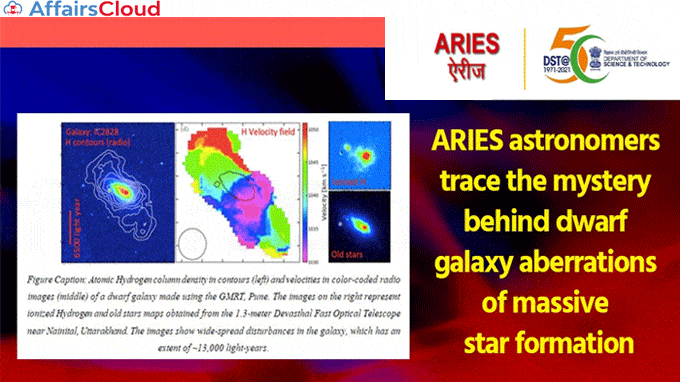 ARIES astronomers Dr Amitesh Omar and Dr Sumit Jaiswal from the Department of Science and Technology of Aryabhatta Research Institute of Observational Sciences (ARIES), Nainital discovered the aberration in the formations of the stars in dwarf galaxies while studying several such galaxies. This will provide an understanding about the formation of stars and evolution of less massive galaxies in the Universe.
ARIES astronomers Dr Amitesh Omar and Dr Sumit Jaiswal from the Department of Science and Technology of Aryabhatta Research Institute of Observational Sciences (ARIES), Nainital discovered the aberration in the formations of the stars in dwarf galaxies while studying several such galaxies. This will provide an understanding about the formation of stars and evolution of less massive galaxies in the Universe.
The Study:
Dr Amitesh Omar and Dr Sumit Jaiswal used two telescopes to study the galaxies.
- Devasthal Fast Optical Telescope (DFOT)(based near Nainital).
- Giant Metrewave Radio Telescope (GMRT).
i.The 1.3 meter DFOT operated at an optical wavelength sensitive to detect optical line radiation emanating from the ionized Hydrogen(H).
ii.GMRT has 30 dishes of 45-meter diameter, which worked in tandem and produced sharp interferometric images through spectral line radiation at 1420.40 MegaHertz(MHz) from the neutral Hydrogen.
Note:
The findings of the study with detailed images of 13 galaxies will be published in the Monthly Notice of Royal Astronomical Society(MNRAS) journal by Royal Astronomical Society, United Kingdom.
Findings of the Study:
i.The rate of formation of these dwarf galaxies are slower than the rate of formation of massive galaxies.
ii.The formation of the stars of the dwarf galaxies are at a mass normalised rate of about 10-100 times more than the milky way galaxy.
iii.These activities do not last longer than a few tens of million years, which is shorter than the age of these galaxies (few billion years).
iv.The scientists identified that the clue for this strange behaviour of these galaxies are in the distributed hydrogen distribution in these galaxies and in recent collisions between two galaxies.
Indications from the Images:
i.The images of the formation of stars indicates that these galaxies are very disturbed and the hydrogen in these dwarfs are irregular and sometimes do not move in the defined orbit.
ii.Hydrogen around these galaxies are detected in the form of isolated clouds, plumes and tails which are like the results of collision of galaxies.
iii.The optical morphologies revealed multiple nuclei and high concentration ionized hydrogen in the central region.
Suggestions:
The recent collisions between two galaxies trigger the intense star formation in the galaxies.
Recent Related News:
i.Astronomers of RedDots Team Discovered Super Earths Gliese 887b and Gliese 887c Near Red Dwarf.
ii.NASA Astronomers Discover 240-year-old Neutron Star ‘Swift J1818.0−1607’ After Recent X-ray Burst.
About ARIES:
Autonomous Research Institute of the Department of Science and Technology(DST).
Director– Dr. Dipankar Banerjee
Location– Nainital, Uttarakhand.




